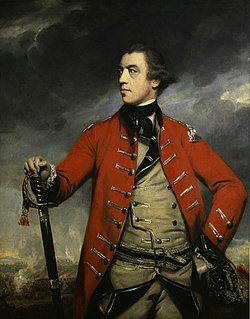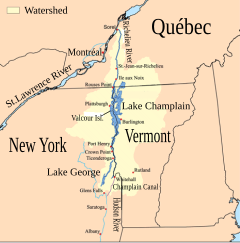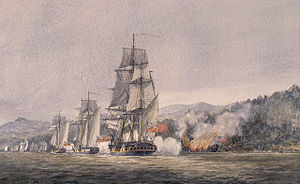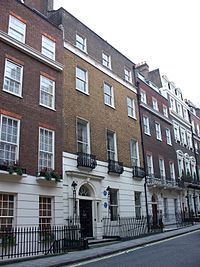Johnny Burgoyne (24 February 1722 – 4 August 1792) was a British army officer, politician and dramatist. He first saw action during the Seven Years' War when he participated in several battles, most notably during the Portugal Campaign of 1762.
John Burgoyne is best known for his role in the American Revolutionary War. He designed an invasion scheme and was appointed to command a force moving south from Canada to split away New England and end the rebellion. Burgoyne advanced from Canada but his slow movement allowed the Americans to concentrate their forces. Instead of coming to his aid according to the overall plan, the British Army in New York City moved south to capture Philadelphia. Surrounded, Burgoyne fought two small battles near Saratoga to break out. Trapped by superior American forces, with no relief in sight, Burgoyne surrendered his entire army of 6,200 men on October 17, 1777. His surrender, says historian Edmund Morgan, "was a great turning point of the war, because it won for Americans the foreign assistance which was the last element needed for victory".[1] He and his officers returned to England; the enlisted men became prisoners of war. Burgoyne came under sharp criticism when he returned to London, and never held another active command.
Burgoyne was also an accomplished playwright known for his works such as The Maid of the Oaks and The Heiress, but his plays never reached the fame of his military career. He served as a member of the House of Commons of Parliament for a number of years, sitting for the seats of Midhurst and Preston. He is often referred to as Gentleman Johnny.
John Burgoyne was born in Sutton, Bedfordshire, location of the Burgoyne baronets family home Sutton Manor,
Sutton, Bedfordshire, location of the Burgoyne baronets family home Sutton Manor,  on 24 February 1722. His mother, Anna Maria Burgoyne, was the daughter of a wealthy Hackney merchant.
on 24 February 1722. His mother, Anna Maria Burgoyne, was the daughter of a wealthy Hackney merchant.
His father was supposedly an army officer, Captain John Burgoyne, although there were rumours that he might be the illegitimate son of Lord Bingley , who was his godfather. When Bingley died in 1731 his will specified that Burgoyne was to inherit his estate if his daughters had no male issue.
, who was his godfather. When Bingley died in 1731 his will specified that Burgoyne was to inherit his estate if his daughters had no male issue.
From the age of ten Burgoyne attended the prestigious Westminster School,
 as did many British army officers of the time such as Thomas Gage
as did many British army officers of the time such as Thomas Gage  with whom Burgoyne would later serve. Burgoyne was athletic and outgoing and enjoyed life at the school where he made numerous important friends, in particular Lord James Strange.
with whom Burgoyne would later serve. Burgoyne was athletic and outgoing and enjoyed life at the school where he made numerous important friends, in particular Lord James Strange.
In August 1737 Burgoyne purchased a commission in the Horse Guards, a fashionable cavalry regiment. They were stationed in London and his duties were light, allowing him to cut a figure in high society. He soon acquired the nickname "Gentleman Johnny" and became well known for his stylish uniforms and general high living which saw him run up large debts. In 1741 Burgoyne sold his commission, possibly to settle gambling debts.
 as did many British army officers of the time such as Thomas Gage
as did many British army officers of the time such as Thomas Gage  with whom Burgoyne would later serve. Burgoyne was athletic and outgoing and enjoyed life at the school where he made numerous important friends, in particular Lord James Strange.
with whom Burgoyne would later serve. Burgoyne was athletic and outgoing and enjoyed life at the school where he made numerous important friends, in particular Lord James Strange. In August 1737 Burgoyne purchased a commission in the Horse Guards, a fashionable cavalry regiment. They were stationed in London and his duties were light, allowing him to cut a figure in high society. He soon acquired the nickname "Gentleman Johnny" and became well known for his stylish uniforms and general high living which saw him run up large debts. In 1741 Burgoyne sold his commission, possibly to settle gambling debts.
The outbreak of the War of the Austrian Succession led to an expansion in the size of the British army. In April 1745 Burgoyne joined the newly raised 1st Royal Dragoons as acornet, a commission he did not have to pay for as it was newly created. In April 1745 he was promoted to lieutenant. In 1747 Burgoyne managed to scrape the money together to purchase a captaincy. The end of the war in 1748 cut off any prospect of further active service.
as acornet, a commission he did not have to pay for as it was newly created. In April 1745 he was promoted to lieutenant. In 1747 Burgoyne managed to scrape the money together to purchase a captaincy. The end of the war in 1748 cut off any prospect of further active service.
 as acornet, a commission he did not have to pay for as it was newly created. In April 1745 he was promoted to lieutenant. In 1747 Burgoyne managed to scrape the money together to purchase a captaincy. The end of the war in 1748 cut off any prospect of further active service.
as acornet, a commission he did not have to pay for as it was newly created. In April 1745 he was promoted to lieutenant. In 1747 Burgoyne managed to scrape the money together to purchase a captaincy. The end of the war in 1748 cut off any prospect of further active service.Elopement
Through his friendship with Lord Strange, Burgoyne came to know Strange's sister Lady Charlotte Stanley, the daughter of Lord Derby, one of Britain's leading politicians. After Derby refused permission for Burgoyne to marry Charlotte, they eloped together and married without his permission in April 1751. An outraged Derby cut his daughter off without a penny. Unable to support his wife otherwise, Burgoyne again sold his commission, raising £2,600 which they lived off for the next few years.
one of Britain's leading politicians. After Derby refused permission for Burgoyne to marry Charlotte, they eloped together and married without his permission in April 1751. An outraged Derby cut his daughter off without a penny. Unable to support his wife otherwise, Burgoyne again sold his commission, raising £2,600 which they lived off for the next few years.
 one of Britain's leading politicians. After Derby refused permission for Burgoyne to marry Charlotte, they eloped together and married without his permission in April 1751. An outraged Derby cut his daughter off without a penny. Unable to support his wife otherwise, Burgoyne again sold his commission, raising £2,600 which they lived off for the next few years.
one of Britain's leading politicians. After Derby refused permission for Burgoyne to marry Charlotte, they eloped together and married without his permission in April 1751. An outraged Derby cut his daughter off without a penny. Unable to support his wife otherwise, Burgoyne again sold his commission, raising £2,600 which they lived off for the next few years.
In October 1751 Burgoyne and his new wife went to live in Continental Europe travelling through France and Italy. While in France Burgoyne met and befriended the Duc de Choiseul who would later become the Foreign Minister and directed French policy during the Seven Years War. While in Rome Burgoyne had his portrait painted by the British artist Allan Ramsey.
who would later become the Foreign Minister and directed French policy during the Seven Years War. While in Rome Burgoyne had his portrait painted by the British artist Allan Ramsey. In late 1754 Burgoyne's wife gave birth to a daughter, Charlotte Elizabeth, who was to prove to be the couple's only child. In the hope that a granddaughter would soften Derby's opposition to their marriage the Burgoynes returned to Britain in 1755. Lord Strange interceded on their behalf with Derby, who soon changed his mind and accepted them back into the family. Burgoyne soon became a favourite of Derby, who used his influence to boost Burgoyne's prospects.
In late 1754 Burgoyne's wife gave birth to a daughter, Charlotte Elizabeth, who was to prove to be the couple's only child. In the hope that a granddaughter would soften Derby's opposition to their marriage the Burgoynes returned to Britain in 1755. Lord Strange interceded on their behalf with Derby, who soon changed his mind and accepted them back into the family. Burgoyne soon became a favourite of Derby, who used his influence to boost Burgoyne's prospects.
 who would later become the Foreign Minister and directed French policy during the Seven Years War. While in Rome Burgoyne had his portrait painted by the British artist Allan Ramsey.
who would later become the Foreign Minister and directed French policy during the Seven Years War. While in Rome Burgoyne had his portrait painted by the British artist Allan Ramsey. In late 1754 Burgoyne's wife gave birth to a daughter, Charlotte Elizabeth, who was to prove to be the couple's only child. In the hope that a granddaughter would soften Derby's opposition to their marriage the Burgoynes returned to Britain in 1755. Lord Strange interceded on their behalf with Derby, who soon changed his mind and accepted them back into the family. Burgoyne soon became a favourite of Derby, who used his influence to boost Burgoyne's prospects.
In late 1754 Burgoyne's wife gave birth to a daughter, Charlotte Elizabeth, who was to prove to be the couple's only child. In the hope that a granddaughter would soften Derby's opposition to their marriage the Burgoynes returned to Britain in 1755. Lord Strange interceded on their behalf with Derby, who soon changed his mind and accepted them back into the family. Burgoyne soon became a favourite of Derby, who used his influence to boost Burgoyne's prospects.
A month after the outbreak of the Seven Years' War Burgoyne bought a commission in the 11th Dragoons. In 1758 he became captain and lieutenant-colonel in the Coldstream Guards.
Raid on St Malo
In 1758 he participated in several expeditions made against the French coast, including the Raid on Cherbourg. During this period he was instrumental in introducing light cavalry into the British Army. The two regiments then formed were commanded by George Eliott(afterwards Lord Heathfield) and Burgoyne. This was a revolutionary step, and Burgoyne was a pioneer in the early development of British light cavalry. Burgoyne admired independent thought amongst common soldiers, and encouraged his men to use their own initiative, in stark contrast to the established system employed at the time by the British army.
and Burgoyne. This was a revolutionary step, and Burgoyne was a pioneer in the early development of British light cavalry. Burgoyne admired independent thought amongst common soldiers, and encouraged his men to use their own initiative, in stark contrast to the established system employed at the time by the British army.
 and Burgoyne. This was a revolutionary step, and Burgoyne was a pioneer in the early development of British light cavalry. Burgoyne admired independent thought amongst common soldiers, and encouraged his men to use their own initiative, in stark contrast to the established system employed at the time by the British army.
and Burgoyne. This was a revolutionary step, and Burgoyne was a pioneer in the early development of British light cavalry. Burgoyne admired independent thought amongst common soldiers, and encouraged his men to use their own initiative, in stark contrast to the established system employed at the time by the British army.
In 1761, he sat in parliament for Midhurst, and in the following year he served as a Brigadier-general in Portugal which had just entered the war. Burgoyne won particular distinction by leading his cavalry in the capture of Valencia de Alcántara and of Vila Velha de Ródão
and of Vila Velha de Ródão
 following the Battle of Valencia de Alcántara,
following the Battle of Valencia de Alcántara, compensating for the Portuguese loss of Almeida.
compensating for the Portuguese loss of Almeida.  This played a major part in repulsing a large Spanish force bent on invading Portugal.
This played a major part in repulsing a large Spanish force bent on invading Portugal.
 and of Vila Velha de Ródão
and of Vila Velha de Ródão following the Battle of Valencia de Alcántara,
following the Battle of Valencia de Alcántara, compensating for the Portuguese loss of Almeida.
compensating for the Portuguese loss of Almeida.
In 1768, he was elected to the House of Commons for Preston, and for the next few years he occupied himself chiefly with his parliamentary duties, in which he was remarkable for his general outspokenness and, in particular, for his attacks on Lord Clive, who was at the time considered the nation's leading soldier. He achieved prominence in 1772 by demanding an investigation of the East India Company alleging widespread corruption by its officials. At the same time, he devoted much attention to art and drama (his first play,The Maid of the Oaks, was produced by David Garrick in 1775).
In the army he had been promoted to major-general. On the outbreak of the American war, he was appointed to a command, and arrived in Boston in May 1775, a few weeks after the first shots of the war had been fired. He participated as part of the garrison during the Siege of Boston, although he did not see action at the Battle of Bunker Hill,
although he did not see action at the Battle of Bunker Hill, in which the British forces were led by William Howe and Henry Clinton. Frustrated by the lack of opportunities, he returned to England long before the rest of the garrison, which evacuated the city in March 1776.
in which the British forces were led by William Howe and Henry Clinton. Frustrated by the lack of opportunities, he returned to England long before the rest of the garrison, which evacuated the city in March 1776.
 although he did not see action at the Battle of Bunker Hill,
although he did not see action at the Battle of Bunker Hill, in which the British forces were led by William Howe and Henry Clinton. Frustrated by the lack of opportunities, he returned to England long before the rest of the garrison, which evacuated the city in March 1776.
in which the British forces were led by William Howe and Henry Clinton. Frustrated by the lack of opportunities, he returned to England long before the rest of the garrison, which evacuated the city in March 1776.
In 1776, he was at the head of the British reinforcements that sailed up the Saint Lawrence River and relieved Quebec City, which was under siege by the Continental Army. He led forces under General Guy Carleton
which was under siege by the Continental Army. He led forces under General Guy Carleton in the drive that chased the Continental Army from the province of Quebec. Carleton then led the British forces onto Lake Champlain,
in the drive that chased the Continental Army from the province of Quebec. Carleton then led the British forces onto Lake Champlain, but was, in Burgoyne's opinion, insufficiently bold when he failed to attempt the capture of Fort Ticonderoga
but was, in Burgoyne's opinion, insufficiently bold when he failed to attempt the capture of Fort Ticonderoga after winning the naval Battle of Valcour Island in October.
after winning the naval Battle of Valcour Island in October.
 which was under siege by the Continental Army. He led forces under General Guy Carleton
which was under siege by the Continental Army. He led forces under General Guy Carleton in the drive that chased the Continental Army from the province of Quebec. Carleton then led the British forces onto Lake Champlain,
in the drive that chased the Continental Army from the province of Quebec. Carleton then led the British forces onto Lake Champlain, but was, in Burgoyne's opinion, insufficiently bold when he failed to attempt the capture of Fort Ticonderoga
but was, in Burgoyne's opinion, insufficiently bold when he failed to attempt the capture of Fort Ticonderoga
Saratogainformation: Saratoga campaign
The following year, having convinced King George III and his government of Carleton's faults, Burgoyne was given command of the British forces charged with gaining control of Lake Champlain and the Hudson River valley. The plan, largely of his own creation, was for Burgoyne and his force to cross Lake Champlain from Quebec and capture Ticonderoga before advancing on Albany, New York, where they would rendezvous with another British army under General Howe coming north from New York City, and a smaller force that would come down the Mohawk River valley under Barry St. Leger. This would divide New England from the southern colonies, and, it was believed, make it easier to end the rebellion.
valley under Barry St. Leger. This would divide New England from the southern colonies, and, it was believed, make it easier to end the rebellion.
 valley under Barry St. Leger. This would divide New England from the southern colonies, and, it was believed, make it easier to end the rebellion.
valley under Barry St. Leger. This would divide New England from the southern colonies, and, it was believed, make it easier to end the rebellion.
From the beginning Burgoyne was vastly overconfident. Leading what he believed was an overwhelming force, he saw the campaign largely as a stroll that would make him a national hero who had saved the rebel colonies for the crown. Before leaving London he had wagered Charles James Fox ten pounds that he would return victorious within a year. He refused to heed more cautious voices, both British and American, that suggested a successful campaign using the route he proposed was impossible, as the failed attempt the previous year had shown.
Underlining the plan was the belief that Burgoyne's aggressive thrust from Quebec would be aided by the movements of two other large British forces under Generals Howe and Clinton who would support the advance. However, Lord Germain's orders dispatched from London were not clear on this point, with the effect that Howe took no action to support Burgoyne, and Clinton moved from New York too late and in too little strength to be any great help to Burgoyne.
As a result of this miscommunication, Burgoyne ended up conducting the campaign single-handedly. He was not yet aware that he would not be gaining additional support, and was still reasonably confident of success. Having amassed an army of over 7,000 troops in Quebec, Burgoyne was also led to believe by reports that he could rely on the support of large numbers of Native Americans and American Loyalists who would rally to the flag once the British came south. Even if the countryside was not as pro-British as expected, much of the area between Lake Champlain and Albany was underpopulated anyway, and Burgoyne was sceptical any major enemy force could gather there.
The campaign was initially successful. Burgoyne gained possession of the vital outposts of Fort Ticonderoga (for which he was made a lieutenant-general) and Fort Edward, but, pushing on, decided to break his communications with Quebec, and was eventually hemmed in by a superior force led by American Major General Horatio Gates. Several attempts to break through the enemy lines were repulsed at Saratoga in September and October 1777. On 17 October 1777, Burgoyne surrendered his entire army, numbering 5,800. This was the greatest victory the colonists had yet gained, and it proved to be the turning point in the war.
Convention Army[edit]
Further information: Convention Army
Rather than an outright unconditional surrender, Burgoyne had agreed to a Convention that involved his men surrendering their weapons, and returning to Europe with a pledge not to return to North America. Burgoyne had been most insistent on this point, even suggesting he would try to fight his way back to Quebec if it was not agreed. Soon afterwards the Continental Congress, urged by George Washington, repudiated the treaty and imprisoned the remnants of the army in Massachusetts and Virginia, where they were sometimes maltreated. This was widely seen as revenge for the poor British treatment of Continental prisoners.
Following Saratoga, the indignation in Britain against Burgoyne was great. He returned at once, with the leave of the American general, to defend his conduct and demanded but never obtained a trial. He was deprived of his regiment and the governorship of Fort William in Scotland, which he had held since 1769. Following the defeat, Francerecognised the United States and entered the war on 6 February 1778, transforming it into a global conflict.
Although Burgoyne at the time was widely held to blame for the defeat, historians have over the years shifted responsibility for the disaster at Saratoga to Lord Germain, theSecretary of State for the Colonies. Germain had overseen the overall strategy for the campaign and had significantly neglected to order General Howe to support Burgoyne's invasion, instead leaving him to believe that he was free to launch his own attack on Philadelphia.
Later life[edit]
Previously Burgoyne had been a Tory-leaning supporter of the North government but following his return from Saratoga he began to associate with the Rockingham Whigs. In 1782 when his political friends came into office, Burgoyne was restored to his rank, given a colonelcy and made commander-in-chief in Ireland and a privy councillor. After the fall of the Rockingham government in 1783, Burgoyne withdrew more and more into private life. His last public service was his participation in the Impeachment of Warren Hastings. He died quite unexpectedly on 4 August 1792 at his home in Mayfair, after having been seen the previous night at the theatre in apparent good health. Burgoyne is buried in Westminster Abbey, in the North Walk of the Cloisters.
After the death of his wife in 1776, Burgoyne had four children by his mistress Susan Caulfield; one was Field Marshal John Fox Burgoyne, father of Hugh Talbot Burgoyne, VC.
Dramatist[edit]
In his time Burgoyne was a notable playwright, writing a number of popular plays. The most notable were The Maid of the Oaks and The Heiress (1786). He assisted Richard Brinsley Sheridan in his production of The Camp, which he may have co-authored.[10] He also wrote the libretti for William Jackson's only successful opera The Lord of the Manor (1780). He also wrote a translated semi-opera version of Michel-Jean Sedaine's work Richard Coeur de lion with music by Thomas Linley the elder for the Drury Lane Theatre where it was very successful in 1788.[11] Had it not been for his role in the American War of Independence, Burgoyne would most likely be foremost remembered today as adramatist.



No comments:
Post a Comment